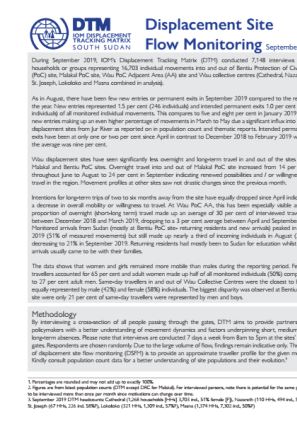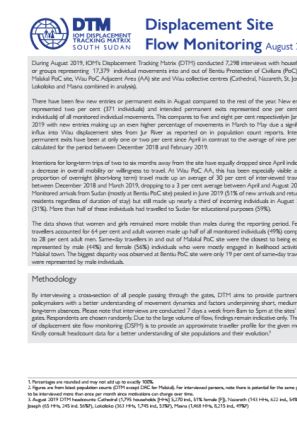-
Countries
-
Data and Analysis
-
Special Focus
-
Crisis Responses
Return migration

Contact
DTMAfghanistan@iom.int
Language
English
Location
Afghanistan
Period Covered
Oct 01 2018
Dec 31 2018
Activity
- Mobility Tracking
- Baseline Assessment
In Afghanistan, DTM employs the Baseline Mobility Assessment tool, designed to track mobility, determine the population sizes, locations and geographic distribution of forcibly displaced, return and migrant populations, reasons for displacement, places of origin, and times of displacement, as well as basic demographics, vulnerabilities and priority needs. Data is collected at the settlement level, through community focus group discussions with key informants and direct observations.
This provincial report summarises the DTM findings in Baghlan. The data has been collected throughout 15 districts and 561 settlements in Baghlan.

Contact
DTMAfghanistan@iom.int
Language
English
Location
Afghanistan
Period Covered
Oct 01 2018
Dec 31 2018
Activity
- Mobility Tracking
- Baseline Assessment
In Afghanistan, DTM employs the Baseline Mobility Assessment tool, designed to track mobility, determine the population sizes, locations and geographic distribution of forcibly displaced, return and migrant populations, reasons for displacement, places of origin, and times of displacement, as well as basic demographics, vulnerabilities and priority needs. Data is collected at the settlement level, through community focus group discussions with key informants and direct observations.
This provincial report summarises the DTM findings in Badghis. The data has been collected throughout 6 districts and 248 settlements in Badghis.

Contact
DTMAfghanistan@iom.int
Language
English
Location
Afghanistan
Period Covered
Oct 01 2018
Dec 31 2018
Activity
- Mobility Tracking
- Baseline Assessment
In Afghanistan, DTM employs the Baseline Mobility Assessment tool, designed to track mobility, determine the population sizes, locations and geographic distribution of forcibly displaced, return and migrant populations, reasons for displacement, places of origin, and times of displacement, as well as basic demographics, vulnerabilities and priority needs. Data is collected at the settlement level, through community focus group discussions with key informants and direct observations.
This provincial report summarises the DTM findings in Badakhshan. The data has been collected throughout 25 districts and 512 settlements in Badakhshan.

Contact
DTM Afghanistan, IOMKabulDTMAllUsers@iom.int
Language
Pashto
Location
Afghanistan
Period Covered
Mar 01 2019
Jun 30 2019
Activity
- Mobility Tracking
- Baseline Assessment
د بېځایه کېدونکوو د تعقیب سیسټم په افغانستان کې د تحرک د ارزونې بنسټیزې وسیلې کاروي ترڅو له تحرکاتو څخه څارنه وشي او د نفوس په هکله اټکلونه، د جبري بېځایه کېدنو موقعیتونه او جغرافیه وي وېش څرګند شي. سربېره پر دې DTM د بېځایه کېدو مهال، علت، اصلی سیمې، لومړني جمعیتی معلومات، زیانمنتیاوې او د اړتیاوو د لومړیتوبونو څخه څارنه کوي. معلومات د کلیو په کچه کلیدي معلوماتو ورکوونکو سره د ډله ایز بحثونو او مخامخ کتنو له لارې راټولېږي.
د ۲۰۱۹ کال جون ۳۰ را په دې خوا په ۳۴ ولایتونو کې ۳۹۲ ولسوالی او ۱۱٬۶۳۶ کلي د ۶۱٬۷۴۸ کلیدي معلومات ورکوونکو سره د مرکې له لارې ارزول شوي دي. له ۲۰۱۲ کال څخه د ۲۰۱۹ کال جون میاشتې پورې ۳٬۳۰۹٬۱۸۸ راستنېدونکي و ۴٬۱۹۱٬۵۲۱ داخلي بېځایه شوي چې اوسمهال په کوربه ټولنو کې اوسېږي پېژندل شوي دي.

Contact
DTMAfghanistan@iom.int
Language
Dari
Location
Afghanistan
Period Covered
Mar 01 2019
Jun 30 2019
Activity
- Mobility Tracking
- Baseline Assessment
DTM در افغانستان از ابـزار ارزیـابی بنیـادی تحـرکات اسـتفاده میکنـد تا تحـرکات ردیابی گردیده معلومات در مورد تخمین مـیزان نفوس، موقعیـت و تقسیمات جغرافیایی جمعیت های بیجا شده اجباری، بازگشت کننده و مهاجر آماده گردد. علاوه بر این DTM دلایـل و زمان بیجاشدگی و محل اصـلی بیجاشدگان را بشمول آمار گیری اسـاسی در مـورد جمعیـت، سـطح آسـیب پذیـری و نیازمندی های اولیه آنان را ردیابی مینماید. اطلاعات از طریـق بحـث هـای گروهی اجتماعی بـا معلومـات دهنـدگان کلیـدی، و مشـاهدات مسـتقیم به سطح قریجات جمع آوری میشـود.
از ۳۰ جون سال ۲۰۱۹ به اینسو در ۳۴ ولایت ۳۹۲ ولسوالی و ۱۱٬۶۳۶ قریه از طریق مصاحبه با ۶۱٬۷۴۸ معلومات دهندگان کلیدی ارزیابی گردیده اند. از سال ۲۰۱۲ الی جون ۲۰۱۹ به تعداد ۳٬۳۰۹٬۱۸۸ بازگشت کننده و ۴٬۱۹۱٬۵۲۱ بیجاشده داخلی که در حال حاضر در جوامع میزبان زندگی میکنند شناسایی گردیده اند.

Contact
DTM South Sudan, SouthSudanDTM@iom.int
Language
English
Location
South Sudan
Period Covered
Sep 01 2019
Sep 30 2019
Activity
- Flow Monitoring
During September 2019, IOM’s Displacement Tracking Matrix (DTM) conducted 7,148 interviews with households or groups representing 16,703 individual movements into and out of Bentiu Protection of Civilians (PoC) site, Malakal PoC site, Wau PoC Adjacent Area (AA) site and Wau collective centres (Cathedral, Nazareth, St. Joseph, Lokoloko and Masna combined in analysis).
As in August, there have been few new entries or permanent exits in September 2019 compared to the rest of the year. New entries represented 1.5 per cent (246 individuals) and intended permanent exits 1.0 per cent (170 individuals) of all monitored individual movements. This compares to five and eight per cent in January 2019 with new entries making up an even higher percentage of movements in March to May due a significant influx into Wau displacement sites from Jur River as reported on in population count and thematic reports. Intended permanent exits have been at only one or two per cent since April in contrast to December 2018 to February 2019 where the average was nine per cent.

Contact
DTM South Sudan, SouthSudanDTM@iom.int
Language
English
Location
South Sudan
Period Covered
Aug 01 2019
Aug 31 2019
Activity
- Flow Monitoring
During August 2019, IOM’s Displacement Tracking Matrix (DTM) conducted 7,298 interviews with households or groups representing 17,379 individual movements into and out of Bentiu Protection of Civilians (PoC) site, Malakal PoC site, Wau PoC Adjacent Area (AA) site and Wau collective centres (Cathedral, Nazareth, St. Joseph, Lokoloko and Masna combined in analysis).
There have been few new entries or permanent exits in August compared to the rest of the year. New entries represented two per cent (371 individuals) and intended permanent exits represented one per cent (92 individuals) of all monitored individual movements. This compares to five and eight per cent respectivelyin January 2019 with new entries making up an even higher percentage of movements in March to May due a significant influx into Wau displacement sites from Jur River as reported on in population count reports. Intended permanent exits have been at only one or two per cent since April in contrast to the average of nine per cent calculated for the period between December 2018 and February 2019.

Contact
DTMAfghanistan@iom.int
Language
English
Location
Afghanistan
Period Covered
Mar 01 2019
Jun 30 2019
Activity
- Mobility Tracking
- Baseline Assessment
In Afghanistan, DTM employs the Baseline Mobility Assessment tool, designed to track mobility, determine the population sizes, locations and geographic distribution of forcibly displaced, return and migrant populations, reasons for displacement, places of origin, and times of displacement, as well as basic demographics, vulnerabilities and priority needs. Data is collected at the settlement level, through community focus group discussions with key informants and direct observations.
As of 30 June 2019, 34 provinces, 392 districts and 11,636 settlements have been assessed, including interviews with 61,748 key informants. Between 2012 and June 2019, 3,309,188 returnees and 4,191,521 IDPs currently living in host communities were identified.

Contact
DTMAfghanistan@iom.int
Language
English
Location
Afghanistan
Period Covered
May 01 2018
Jun 30 2018
Activity
- Mobility Tracking
- Site Assessment
In coordination with the Ministry of Refugees and Repatriation (MoRR), in May through June 2018, DTM in Afghanistan piloted a Community-Based Needs Assessment (CBNA), intended as an integral component of DTM's Baseline Mobility Assessment to provide a more comprehensive view of multi-sectoral needs in settlements hosting IDPs and returnees.
Despite high incidents of conflict, 46% of houses were not damaged, 30% were moderately damaged, 18% were severely damaged and 6% were completed damaged. After Kabul, Nangarhar reported the highest percentage (14%) of households that were unable to afford rent in the six months prior to assessment. The main barriers to accessing housing were the unavailability of housing options, inability to build temporary tents or accommodation, and high rent costs.

Contact
DTMAfghanistan@iom.int
Language
English
Location
Afghanistan
Period Covered
May 01 2018
Jun 30 2018
Activity
- Mobility Tracking
- Site Assessment
In coordination with the Ministry of Refugees and Repatriation (MoRR), in May through June 2018, DTM in Afghanistan piloted a Community-Based Needs Assessment (CBNA), intended as an integral component of DTM's Baseline Mobility Assessment to provide a more comprehensive view of multi-sectoral needs in settlements hosting IDPs and returnees.
The unemployment rate for men in Laghman was 62%. Across the five districts assessed, unemployment ranged between 51% in Qarghayi and 70% in Dawlatshah. Female participation in employment was very low, whereby 99% of women were unemployed. The main barriers to employment ranked by importance included lack of economic opportunities, lack of opportunities for women, and lack of vocational training. Across the seven provinces, the average percentage of employed children (1%), the elderly (1%) and women (1%) was comparatively low.
Pagination
- Previous page
- Page 45
- Next page
